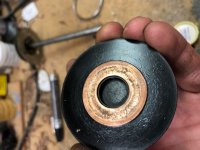71TR6
Jedi Hopeful
Offline
Hello All,
I'm refurbishing my TR3A's WT618 windtone horns and ran into a slight issue. I was able to get a copy of the Lucas Windtone Horn article " Hints from Austin's Morris Garage" and noticed that the current draw should be 2.5-3A. After pulling the pin out, polishing it, lubricating it and then reassembling and adjusting, the best current draw I can get is 8.6A. This is better than the original 11.1A it was drawing before cleaning but still more than double what it is supposed to be drawing.
Anyone have any thoughts on why these horns are still drawing so much current or is this normal for a 60 year old horn? I really, really, really don't want to fry my wiring harness or toast the horn switch after I reinstall these horns.
Thanks,
Ron W
59 TR3A in pieces but going back together
71 TR6
I'm refurbishing my TR3A's WT618 windtone horns and ran into a slight issue. I was able to get a copy of the Lucas Windtone Horn article " Hints from Austin's Morris Garage" and noticed that the current draw should be 2.5-3A. After pulling the pin out, polishing it, lubricating it and then reassembling and adjusting, the best current draw I can get is 8.6A. This is better than the original 11.1A it was drawing before cleaning but still more than double what it is supposed to be drawing.
Anyone have any thoughts on why these horns are still drawing so much current or is this normal for a 60 year old horn? I really, really, really don't want to fry my wiring harness or toast the horn switch after I reinstall these horns.
Thanks,
Ron W
59 TR3A in pieces but going back together
71 TR6

 Hi Guest!
Hi Guest!

 smilie in place of the real @
smilie in place of the real @
 Pretty Please - add it to our Events forum(s) and add to the calendar! >>
Pretty Please - add it to our Events forum(s) and add to the calendar! >> 


